At the beginning of 2021, I created a job description for a new Marketing Manager position here at Wildbit.
I knew what we needed and what we wanted, but I anticipated some ambiguity about the role and the kind of person who might succeed in it. I made a short video about what and who we were looking for, an overview of what that person’s responsibilities would be, and what the successful applicant would get in return.
What I didn’t know was that hiring for this particular role would fundamentally change how we hire at Wildbit. We’ve begun referring to this as “hiring in the open”—a commitment to being as honest, visible, and communicative as possible at every stage of the hiring process in a way that aligns with our people-first values as a company.
What began as a fairly routine process ultimately became an experiment in radical transparency and a valuable learning experience for me personally. It showed me what we did well when it came to hiring, but more importantly, it revealed where we were falling short.
Let’s start from the beginning.
An accidental experiment in transparency
Writing job descriptions can be deceptively difficult. Being too specific risks positioning the role as only suitable to candidates who meet 100% of the stated requirements or those with previous experience in very similar jobs.
Similarly, being too vague can result in disappointment and frustration in candidates who feel they met many of the requirements listed in the job description and can have a detrimental impact on candidates’ mental wellbeing. Hiring managers and job seekers often invest a considerable amount of time and effort into the hiring process, which makes getting job descriptions right that much more important.
One of my primary goals in creating the job description and video was to offer prospective candidates a better idea about what to expect from the role itself, from me as a manager, and from Wildbit as an organization.
I wanted to help applicants better understand my personal values and expectations, as well as the values and ideals that define Wildbit’s culture as a company. I also wanted to proactively address potential questions or objections candidates might have about the role—all of which is surprisingly difficult to do within the confines of a job description. 😅
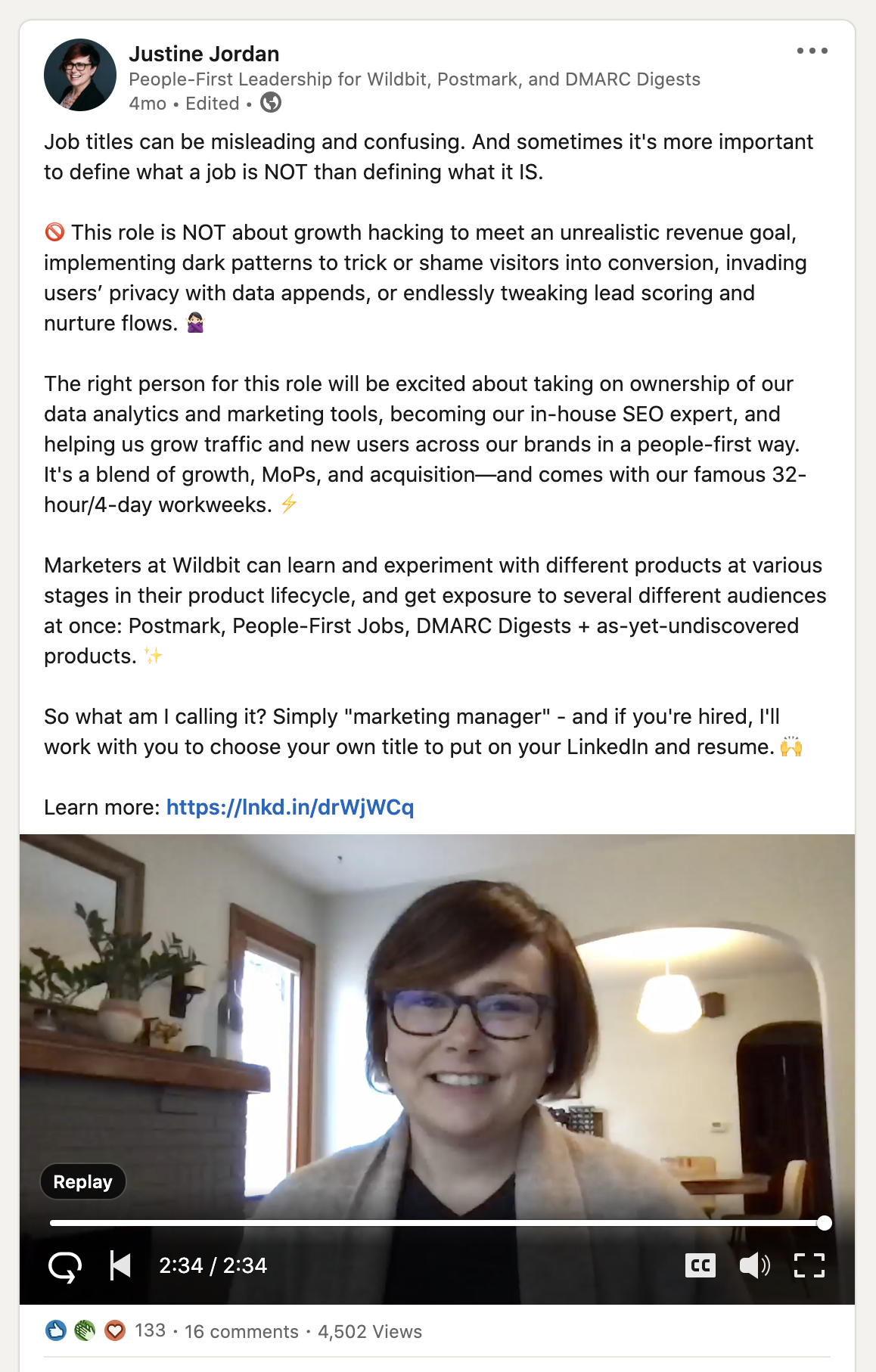
Part of the reason for the relative ambiguity about the specifics of the role was the fact that this job would be a little more fluid than it might at a larger or more traditional company. Some companies might describe the position as a “growth marketing” role, but I deliberately avoided using this kind of language.
Growth marketing can imply a whatever-it-takes attitude that prioritizes revenue above all else and often relies on deceptive practices that abuse users’ trust and disrespects their privacy. Since Wildbit is product agnostic, this role would be involved in a wide variety of brands, products, and projects, and I was hoping to attract people who would be excited and energized by our approach.
It was important to me to be respectful of candidates’ time and effort, and to use this as an opportunity to demonstrate Wildbit’s organizational values in a tangible way. I also wanted to intentionally narrow the candidate pool and provide enough information so that candidates could self-select out of the process or tailor their application to the role. I’d rather read 90 great applications than 900 that range from great to terrible.
Shortly after creating the job description and video, I shared both via LinkedIn along with a few private communities I belong to.
I’m fortunate to have a fairly sizable professional network. Thanks to the generosity of former colleagues and contacts, the post gained a lot of visibility quickly. It didn’t take long before I started getting positive feedback—and lots of questions—from Twitter and LinkedIn as well as Facebook and Slack communities. The questions people were asking brought clarity to the role for me—and, I figured, would also bring clarity to prospective candidates. But the vast majority of those conversations were happening privately via DMs.
That’s what prompted me to create a “living FAQ” for the role. The questions people asked covered almost every conceivable aspect of the role:
- How technical would it be?
- What skills were required of the successful applicant?
- How much experience should that person have?
- Would less experience be a disqualifying factor?
- How do we measure success on the marketing team?
- Why did the position span so many responsibilities?
- Would the successful applicant communicate with Wildbit’s “C-suite”?
- Would the Marketing Manager have direct reports?
Creating a living document allowed me to answer these questions in depth as they arose. It may sound a little selfish, but it also made it possible for me to funnel all those questions into one place, where I could manage a “unified” inbox rather than field questions across multiple channels.
After just a few days, the document had ballooned to several pages. Ultimately, it would be 19 pages long.
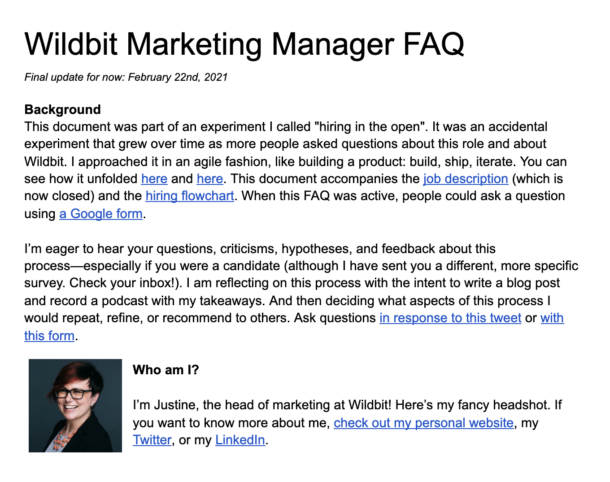
As hiring kicked off, I quickly realized it would be helpful to give ourselves and candidates a better idea of what to expect at each stage. To this end, I created a hiring flowchart in Whimsical to create some structure and visualize the process.
However, we didn’t know precisely what this flow would look like initially. I definitely didn’t go into this process with a clearly defined hiring flowchart ready to go—the flowchart was just as much a living document as the FAQ was. This ambiguity was also an element I had to refine as I went.
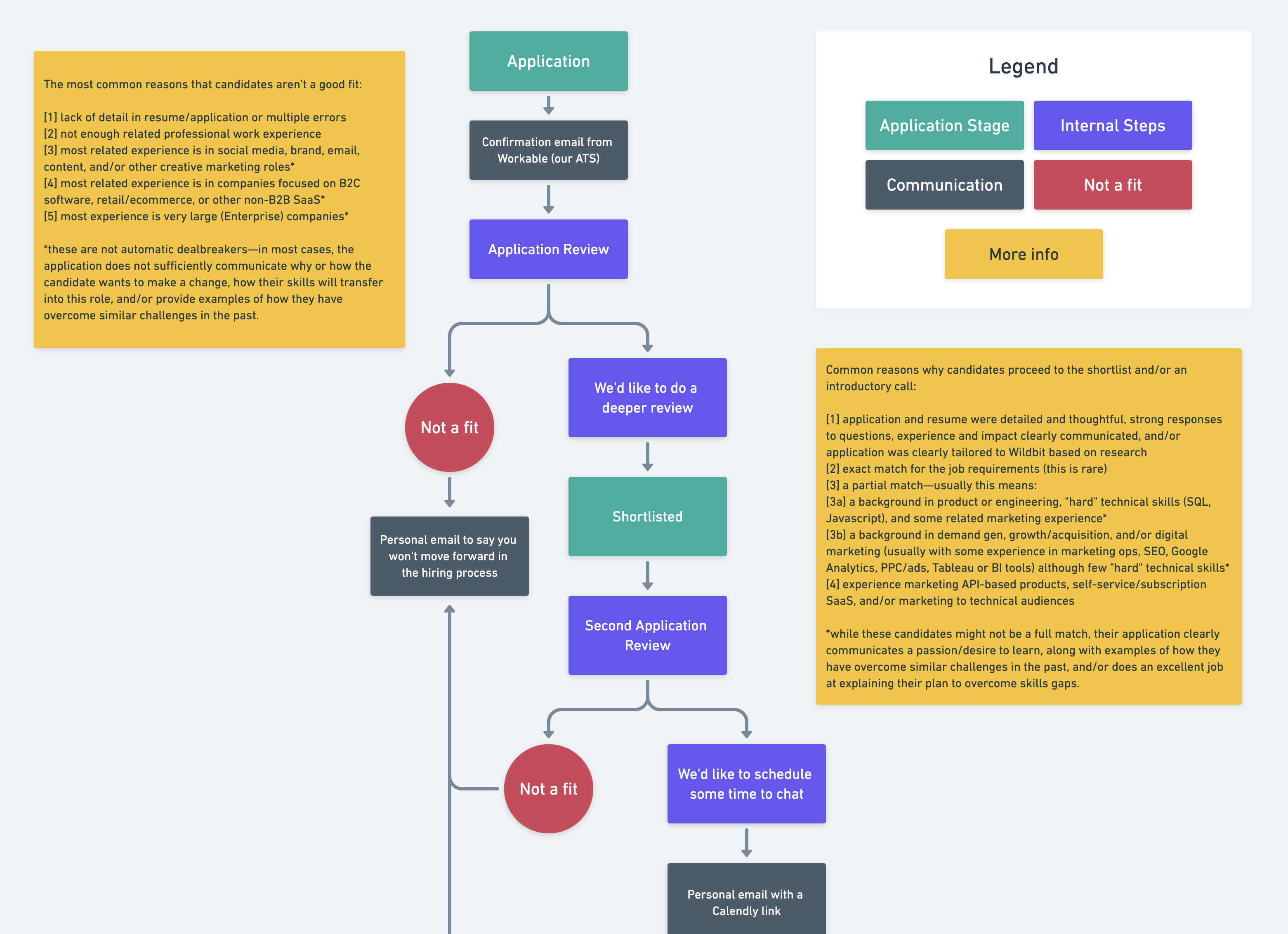
In the beginning, I wasn't sure if candidates would meet with another Wildbit team member or advance to a project after speaking with me. I was as clear as possible about this with prospective candidates, and this flowchart quickly became another way to document and communicate how the process was evolving over time and why we were making certain decisions. You can see the final flowchart, along with how I communicated the evolution of the process, here.
This process forced me to critically examine why I was passing on some candidates and advancing others. We found ourselves reflecting on which qualities were truly essential to the role, versus those that would be “nice to haves.”
I spoke with more candidates than I would have in a more conventional hiring process due to the ongoing dialogues that the FAQ encouraged. And engaging in a more direct, human hiring process gave prospective candidates a much better idea of my management and communication styles.
My marketing background leads me to see the parallels between a landing page and a job posting. Both have a responsibility to communicate a clear message to their intended audience. In that sense, the early phase of the process felt like doing messaging testing.
Despite our best intentions, it’s not always easy to truly understand how someone else might read our words or the intent behind them.
These conversations gave me much-needed clarity about how the role was perceived, and the FAQ and flowchart experiments helped me share that clarity in real time. This approach was also an experiment in communicating with prospective candidates in a personal way, but at scale. This might sound contradictory, but I wanted—and needed—to be both authentic and efficient in my search.
Investing in a people-first approach
There were many pros and a few cons to this approach.
One of the primary benefits was that, although it required a greater investment of time up front, it ultimately made the hiring process more efficient. By the time I began speaking with candidates, they had a considerable understanding of the scope of the role, my management style, our expectations, and Wildbit’s culture.
This meant more substantial interviews in which both I and the candidates could focus on meaningful questions rather than use valuable time to establish the context of the role or go over the basics. One of the downsides to this approach, however, was that it shifted more of the burden onto the candidates themselves by asking them to keep up with a document that was constantly being updated.
Another benefit of this approach was that it encouraged several candidates to follow up on their initial applications and provide additional information as the FAQ grew. This led to me having several conversations that I wouldn’t have had otherwise.
One candidate, for example, said:
“I read through the FAQ again and it's grown a lot since I initially applied! Based on the additional context and guidance, I realized that I could've certainly expanded on my answers and given a fuller picture of myself and my experiences in my initial application. In the spirit of your FAQ, I'm including a few additional comments below, although I understand if you are not able to consider additional information at this point.”
The expanded answers that the candidate submitted persuaded me to speak with them, whereas their initial application alone had not.
Some of the questions people asked revealed areas in which I could have been clearer, especially regarding how I’d measure success for the role. It took me more than half a day to answer this question in a way I felt comfortable sharing publicly, which showed me that I hadn’t been as clear as I could have been about my expectations. This also served as an important reminder that managers and leaders should be communicating these expectations to their team, and such expectations are infrequently part of the hiring process itself.
In that moment of reflection I realized that if I needed a half-day to write an answer I was proud of, were there similar gaps in my expectation-setting with my team? Did they understand how their success was being measured? It was a powerful moment.
Engaging in meaningful dialogue leads to better results
One candidate in particular checked most of the boxes for some aspects of the role, but it was harder to gauge whether they met other “requirements” we wanted. Rather than disqualify this person and move on, I reached out and asked for more information.
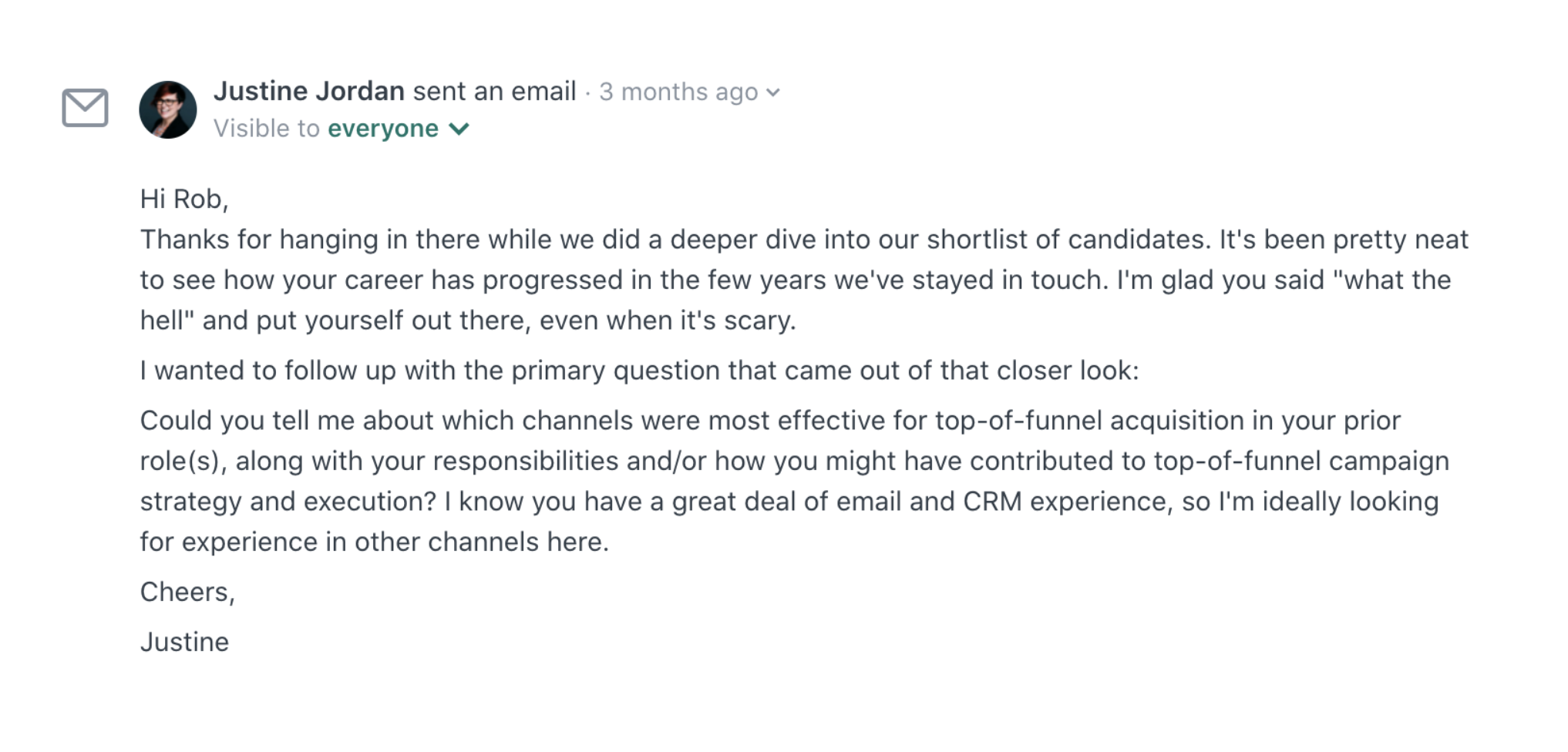
Rob's response was thoughtful and in-depth and gave me a much better idea of how he would approach the top-of-funnel aspects of the role. I really enjoyed the accidentally asynchronous aspect of this conversation, and it also gave me some important insights into how this candidate communicated via email, which is vitally important at Wildbit. Note: you can read Rob's full response here.
As it happens, Rob was the candidate we ultimately hired for the Marketing Manager role. If we had opted for a conventional hiring process, it's unlikely that Rob would have been hired, and we would have missed out on a great candidate and team member.
Replicating and refining the process
The Marketing Manager role wasn’t the only position that we opted to experiment with variations on a more human approach. Leia Rollag, our Head of People, created a living FAQ for the Workplace Experience Manager role, which ended up being a relatively svelte six pages long.
The Workplace Experience Manager role received about 5 times more applications than we received for the Marketing Manager position. Unlike the Marketing Manager role—which I only posted to my personal network, LinkedIn, and the Wildbit website—Leia posted the Workplace Experience Manager role much more widely and proactively sought out candidates from AngelList.
Greater visibility means we’re more likely to see greater diversity in our candidate pool, but what works for one role may not necessarily work for another. We’ll be paying close attention to this in the future.
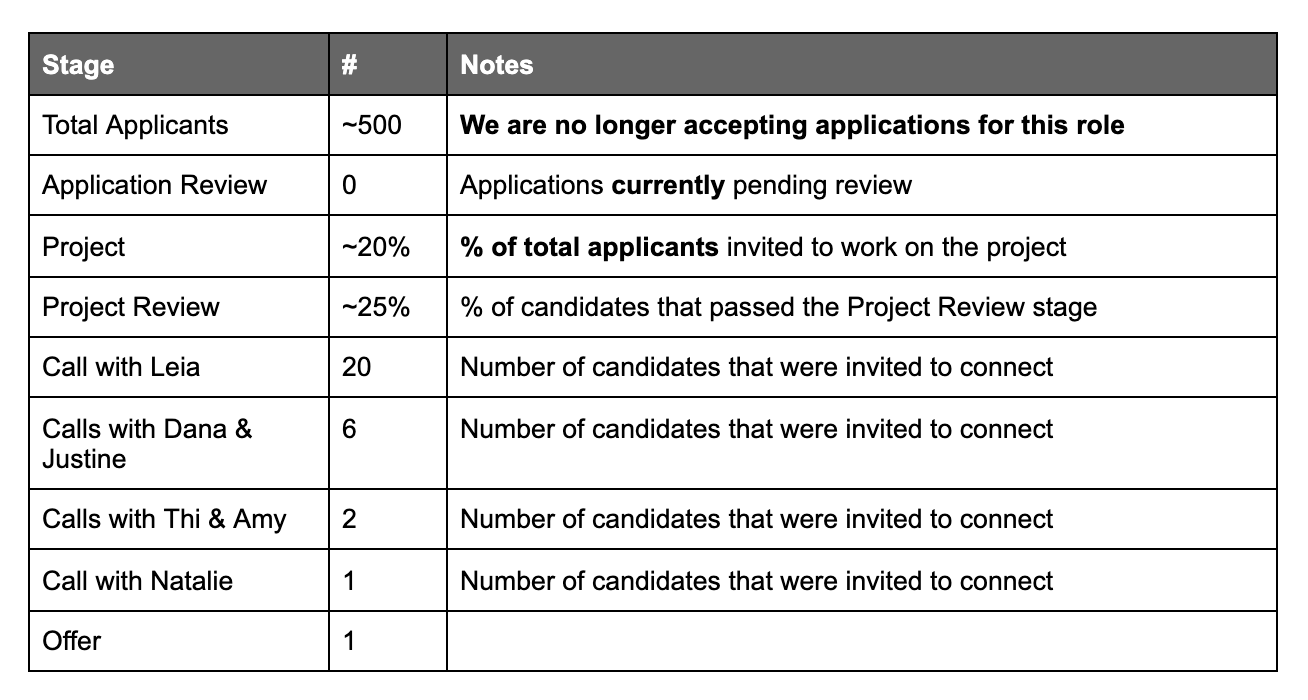
One of the biggest positives for Leia was how many people self-selected out of the process as a result of the clarity offered by the FAQ. Approximately 10% of prospective applicants who were invited to complete a sample project opted out of the process after submitting an application.
It’s very normal for these kinds of remote administrative roles to receive this volume of interest. A good number of people just want to get their foot in the door, especially if the company puts people first. Others are looking for any type of remote work, especially in a pandemic.
Since administrative roles like this don't require many years of experience, a lot of people are qualified and a lot of people apply. But, since the applicants' focus is elsewhere, they tend to not fully think through what it would mean to be in the role both financially and with respect to their level of responsibility. The FAQ enabled individuals who were more senior to self-select out after having visibility into the salary band and asking themself if they'd be happy in a role like this for at least a few years without the role substantially changing.
Just because you’re qualified for a role doesn’t necessarily mean that it’s the right role for you today.
Making space for feedback
The default setting in most applicant tracking systems is configured to send rejection emails from no-reply addresses or aliases that don’t accept responses. This not only discourages dialogue, but can also cause hiring managers to believe doing so is a “best practice.”
Form rejections and unmonitored mailboxes don't offer space for candidates to ask for feedback or follow up or make their case, which some candidates did after Leia reached out to them personally. This didn’t necessarily make a difference in terms of whether candidates advanced or not, but it did make the process feel more human and offered applicants a more positive experience, even if the overall outcome was negative.
“Thank you for getting back to me. While I’m disappointed to hear that I was not selected to move forward with my application for the Workplace Experience Manager role, I greatly appreciate you letting me know.
If you have a moment to spare, I would be interested to hear any feedback you have regarding my application. I’m sure any details you can provide would be helpful to my job search. Thank you again for your time and consideration, Leia. I hope our paths cross again, and I wish you and the rest of the team at Wildbit all the best moving forward.”
Another aspect of recruiting that might explain the prevalence of generic form rejections is employers’ fear of potential litigation from unsuccessful candidates.
Although employers typically have significantly more power than applicants during the recruitment process, employers can be sued by rejected applicants on the basis of bias. Companies that don’t have highly specific criteria about the necessary qualifications for a given role or a clear hiring rubric may inadvertently lead candidates to believe they were unfairly disqualified.
It may be easier and faster to send generic emails or to use a no-reply address, but that’s putting our needs as a business above respecting the time and effort that candidates put into their applications.
People-first recruitment is a long-term process of building relationships, not a cold, impersonal transaction.
Exploring inequities in hiring
Lots of companies talk about prioritizing diversity and equality, but much less attention is given to the often considerable power differential that exists between employers and prospective candidates.
Many companies like to say that applicants are interviewing companies as much as companies are interviewing applicants. However, this assumption ignores the fact that this usually isn’t true until candidates have significant experience and seniority, and that candidates from underrepresented backgrounds often have very different experiences of the interview process and the workplace in general—perpetuating issues that are already chronic in tech and other fields. The living FAQ felt like a tangible way we could try to remedy this imbalance, at least in the context of this particular role.
One of the worst aspects of job hunting from the candidate’s perspective is spending hours on a single application, only to hear absolutely nothing back from the employer one way or another.
This phenomenon is known as “ghosting,” a term that originated in the online dating world.
Understanding why ghosting happens
The true extent of employer ghosting is contentious, depending on which side of the desk you’re on. Some sites claim that just 18% of applicants have been ghosted by prospective employers—a figure that seems almost unbelievably low based on anecdata from groups like Tech Ladies. But irrespective of how often ghosting happens on either side, the problem is rooted in a perception of disrespect for people’s time and effort.
Hiring demands a lot of time and attention. With some roles attracting hundreds of applicants, crafting a personalized rejection for each candidate isn’t realistic in many scenarios—and may be limited by the recruiting software (or lack thereof) being used behind the scenes. That said, simply ignoring the many hours candidates often spend on the application and interview process sends a powerful message to applicants that their time simply isn’t as valuable.
Of course, that’s not to imply that all hiring managers are bad people or don’t care about candidates’ time—in my experience, it’s often quite the opposite. Many hiring managers simply don’t have the internal support they need to hire in a more “human” way. I ran into this myself at previous employers. I barely had enough time to read resumes, let alone craft individual responses to candidates who weren’t being considered for advancement.
Practicing compassionate rejection
Some hiring teams may not have the tools, resources, or awareness to practice more thoughtful ways of rejecting prospective candidates. And for some companies, hiring is often reduced to keyword searches or pass/fail logic; candidates who don’t meet all of the “requirements” and cannot hit the ground running on day one are disqualified out of hand.
We could pretty much toss the traditional hiring playbook in the trash and try new things that wouldn’t be possible at other companies.
I made a conscious decision to speak with candidates who did not have all of the skills and experience outlined in the job description in an effort to diversify our hiring pool. Some candidates, for example, were experienced growth marketers who had most if not all of the skills we asked for—the majority of whom were white men.
Others didn’t yet have certain skills but had relevant and interesting backgrounds that lent themselves well to the role, such as experience in product management and product marketing. As a result of these conversations, we had some important internal discussions about the role and whether to reduce its scope or relax our requirements. This might be anathema to some companies, but we found it valuable to ask ourselves why we were asking for certain skills or why specific experience was necessary.
Evaluating potential vs existing skills
I believe that people should be evaluated by their potential, not by the sum total of their existing skills. Something I realized early on was that there were two main categories most folks tended to fall into:
- Experienced marketers that didn't yet have “hard” technical skills such as JavaScript, SQL, and Tableau
- Experienced technical candidates that were eager to gain marketing experience
I discussed this observation with Matt West, who was part of the hiring team. Matt and I agreed that marketing concepts were “easier” to teach than hard technical skills, though this was obviously not without its challenges. While teaching technical skills was definitely possible, it came with significant overheads in terms of the impact on other team members’ time. We also agreed that doing so demanded the kind of training framework we don’t currently have in place, meaning we leaned toward teaching marketing skills to technical candidates.
While we knew we needed someone with the technical know-how to work confidently with our products and systems, we didn’t want to rule out prospective candidates from unconventional backgrounds who might not yet have these skills.
We also realized that our existing tools and workflows may be unnecessarily complex, and that simplifying them may ultimately benefit the entire company while simultaneously broadening our candidate pool.
This raised several broader topics for further discussion:
- Interviewing candidates from unconventional backgrounds meant the overall process might take longer, which had obvious short-term implications for the marketing team and company as a whole.
- We might have to invest more time and effort into training or mentoring such a candidate, which we hadn’t factored in initially.
- Simplifying our internal workflows may be beneficial in the long-term, but doing so would also have a significant impact on the requirements of the role. For example, we might diversify our candidate pool by opting for a deep understanding of Excel over formal SQL knowledge.
- We could opt to replace tools we use every day, such as Mode and Snowplow, with simpler tools that require less technical knowledge, but that raised even more questions and expanded our hiring timeline indefinitely.
Communicating the zigs and zags
Why share all these details? Because these internal discussions are all too common in the hiring process, and can delay or derail communication with candidates who have already applied and are eagerly awaiting an update on their status.
The trajectory of the hiring process is rarely a predictable, straight line. This is especially true in small teams, unique roles, and early hires. The volume of applications, experience of the candidate pool, or any number of factors may introduce new information during the hiring process.
These unexpected zigs and zags can be especially frustrating to candidates. They might introduce a lag in communication time while the company considers how the information should influence the hiring process, or it might mean that steps in the hiring process are moved around, added, or removed.
A valuable lesson in empathy
Feedback about our hiring in the open experiment was overwhelmingly positive.
To understand how candidates felt about the process and identify areas in which we could improve, we asked all applicants for the Marketing Manager role to complete a candidate experience survey detailing their experiences. We received 16 responses, which was about 18% of applicants.
As you can see in the candidate survey responses, the majority of candidates felt that the hiring team got an accurate sense of their experience, thought we had been responsive to their feedback and questions, and felt comfortable during the process.
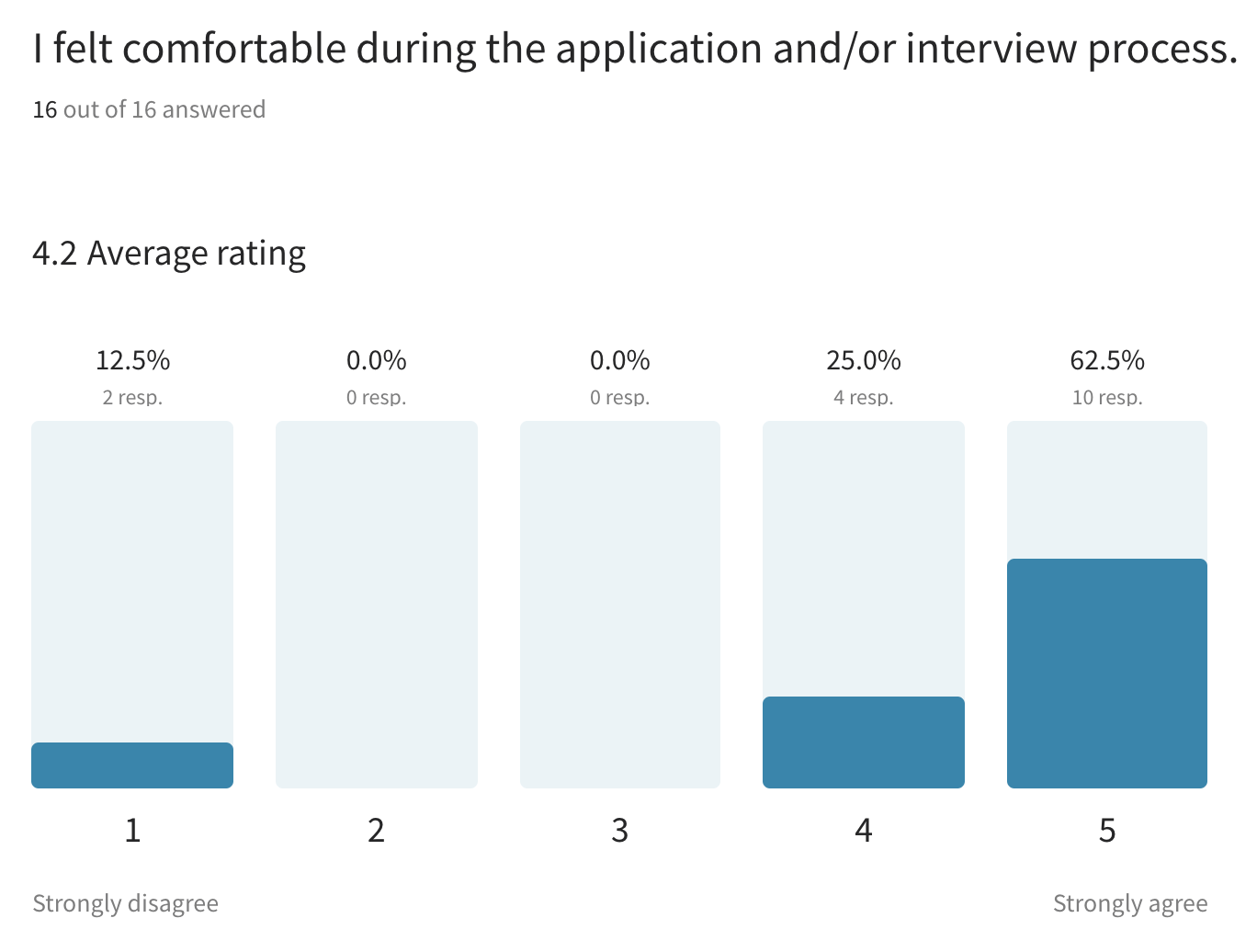
A majority of candidates who completed the survey would also recommend Wildbit to friends and colleagues considering applying for new roles, which is another positive sign that the experiment was a step in the right direction.
As I expected, there was more favorable feedback from those who advanced to an interview; and less favorable scores from those who only submitted an application.
Outside of the survey, Leia and I received dozens of messages regarding this approach through email and other channels. Many candidates expressed genuine gratitude for the respect and care that went into their experience applying, interviewing, and even being disqualified. The most consistent theme in candidate feedback about the experiment was how “human” the process felt. Most applicants told us they found the transparency refreshingly honest, and respectful of their time and effort, which was one of the primary goals of the experiment.
“Thank you so much for your consideration and authenticity. I've never participated in a hiring process that feels so human, and it's very refreshing.”
Another pleasant trend we noticed was how positive the majority of candidates were when we told them that they wouldn’t be advancing further. Even people who had decided not to apply for the role took the time to tell us how much they valued the process.
“This is probably the most fascinating recruiting email I've received in a long time. Despite knowing I'm not leaving my company in the near-term, I read through your entire FAQ—yes, on a Saturday night. I absolutely love the approach to hiring as well as the role scope.”
One of the drawbacks of the process that surfaced from candidate feedback was that, while greater transparency was ultimately a positive for the majority of candidates, it did create a sense of false hope for some.
Other candidates noted that it was difficult to keep track of changes and updates made to the living FAQ. Tools like Almanac seem like promising ways to make this approach less intimidating to some candidates and the basis for future experiments.
Some applicants also said that they felt pressured to keep up with the document, and that this created an element of anxiety for candidates who had already submitted their applications at an earlier stage of the process.
Hiring in the open: build, ship, iterate
For me, one of the biggest takeaways from this process was the significant initial time investment that was necessary to make this process work. From a purely operational perspective, I’m honestly not sure whether that up-front time investment was ultimately worth the time saved hiring for this role.
I didn’t work late into the night because I had to—but because I wanted to give each candidate and application the care and attention they deserved. Similarly, when Leia worked “overtime” on the Workplace Experience Manager role, it was out of a commitment to improving the candidate experience and being as thoughtful as possible with prospective hires, not out of a sense of obligation coming from Wildbit as a company.
That said, I’m glad this experiment unfolded the way it did. This was arguably the most rewarding hiring process I’ve ever been a part of, as well as one of the most instructive. I was genuinely moved by some of the feedback I received from candidates, and it’s shown me how we can—and should—make recruitment a process that puts the needs of people above those of businesses.
We believe that all companies should be people-first companies, which is why we wrote this nearly 5,000-word post and why we created People-First Jobs. We’re dedicated to advocating for people-first business practices, and are committed to encouraging other companies to do the same.
Throughout the journey we weren’t afraid to move on from things that no longer serve us, to take calculated risks, and to welcome what we learned regardless of the outcome.
Through the hours spent building, shipping, and iterating, we were energized by every chance to improve. If this sounds familiar, these sentiments are a direct reflection of our values as a company.
I also learned that, despite some missteps and inefficiencies, this process can be replicated for various roles of differing seniorities. We’ve already begun implementing frameworks around much of the process, which makes those long hours in the earlier days of the experiment more than worthwhile.
I’d love to hear your thoughts on this process and how we might improve it in the future. To everyone who applied for these roles, we’d like to once again extend our deepest thanks for helping us hire in a more human way, and for being a part of one of the most exciting and memorable experiences of my career.

